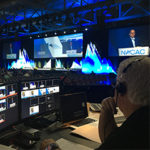
The big one is live and streaming video. It baffles me how we can continually put on fabulous events, have an all-star lineup of speakers, fantastic sessions, and much of the time they’re not videotaped or shared. The cost is coming down dramatically to livestream event programming and share it with a global audience. If you’re an event producer, why not capture content and have it shared year-round to communicate with members? Right now, there’s a lot of “fire and forget.”
One of the big trends that we see — and I expect will get only bigger in the coming years — is real-time polling. Essentially when a presenter presents, they’ll be able to reach out to the audience, ask a question, and find out in real time, or in a matter of seconds, the audience’s opinion to the issue at hand. One of the interesting pieces of this is not only that it makes for more dynamic dialogue, but it also helps you create more newsworthy and noteworthy moments. Essentially any of the data or findings that you produce, especially if you’ve got several hundred people in the audience size, is a pretty significant sample that you can then share and use to generate additional media and publicity for your event.
Gamification obviously has the potential to greatly enhance learning and educational efforts of just about every kind of meeting, because the reality is, you make something more fun and engaging. When it is interactive, it’s more likely to stick. The challenge has been finding a clever and intuitive way to integrate some of that team-based learning or gamification into the programming.
Typically what you see is that somebody will introduce an interactive session or two, but they will not necessarily make the process of networking a game, they will not necessarily make the process of attending sessions and/or consuming certain levels of content a game, and they will not layer the very successful practices as meta-games on top of the event’s experience. The potential is enormous. The challenge in many ways is a challenge of design thinking. It’s not necessarily a challenge of programming or logistics.



